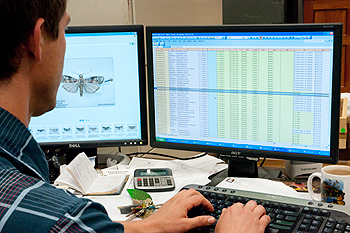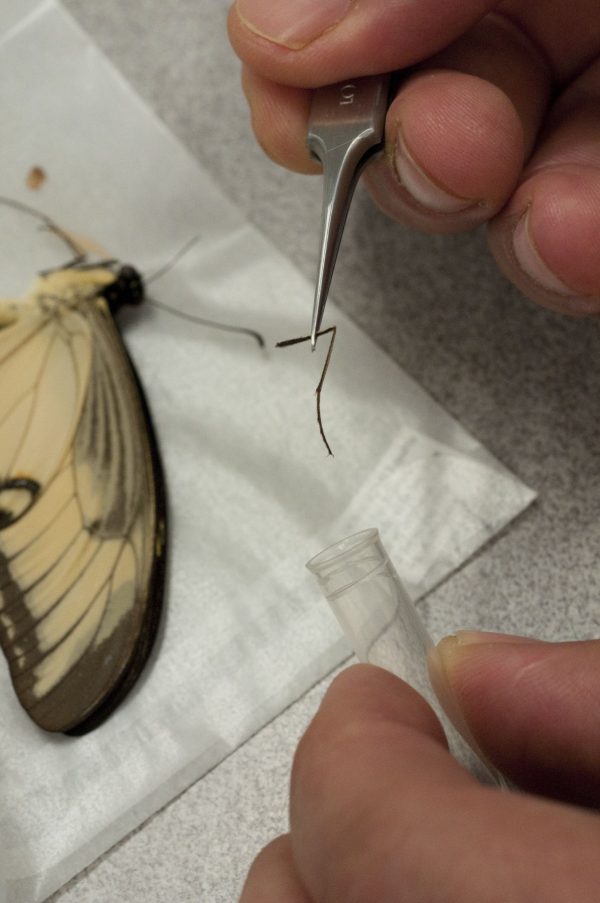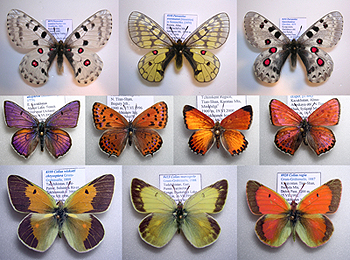
Photo by Jeff Gage
A new study from a Florida Museum of Natural History researcher has shown that a genetic technique for identifying butterfly species can be used over large geographical ranges and suggests that a universal DNA database could be used as a powerful tool for butterfly identification.
Known as “DNA barcoding,” the method examines the same section of mitochondrial DNA in each specimen and determines the butterfly’s species based on differences and similarities found within the genetic code.
Most previous research on the ability of DNA barcoding to identify species has focused on single localities, but the new study applies the technique to a much wider geographic area. The researchers used the method to assess geographic variation among populations of the same species separated by as much as 3,000 miles.
“We wanted to see how increasing the geographic coverage would affect the method’s accuracy,” said Andrei Sourakov, study co-author and Lepidoptera collections coordinator at the Florida Museum. The study, which examined more than 1,000 specimens of Central Asian butterflies, appeared online in February in the journal Molecular Ecology Resources.
The study found that in 95 percent of cases, the DNA variation found among geographically distant individuals of a single species was still lower than the variation found between species. That difference in variation leaves a “barcode gap” that allows for categorizing specimens into previously recognized species, Sourakov said.
Expanding the spatial scale did increase genetic variation within each species, he said, but that increase did not undermine the ability to distinguish between species through the method of cluster analysis, which statistically identifies groupings of closely related individuals.
Barcoding may point the way toward a more objective method of defining species, Sourakov said. “We are talking about automated identification, splitting specimens into clusters or groups that can be clearly defined as species.”
Some are skeptical
Many researchers have been skeptical that the DNA-barcoding method could be used to establish a universal database for species identification. Challenges at large geographic scales are different than those faced at local scales, where it’s possible to collect a comprehensive sample of species and their genetic variation.

Florida Museum photo by Jeff Gage
“Until now it has been very difficult to get large-scale geographic representation for diverse groups,” said Keith Willmott, the Florida Museum’s assistant curator of Lepidoptera.
DNA barcoding has its limitations, Willmott said. Using the method requires that samples have been collected throughout the geographical range and already identified using traditional means in order to know the full genetic and taxonomic variation found within each species.
“It might be necessary to use different methods for DNA barcodes to work, and one of the problems is that they therefore become less predictive of species identity at broader scales,” he said. “I think barcoding could be a useful tool to identify the majority of species, but it needs to be integrated with our existing knowledge and not just be used as a new, standalone method.”
Importance of museum collections
Collected butterfly specimens that had never been pinned were frequently looked upon by collection managers as less important than materials that had been rehydrated and placed in collections, Sourakov said. But by virtue of not having been processed for curation, these materials have better preserved DNA that lends itself to barcode analysis.
“Here we are looking at a methodology that gives a second life to the collections,” he said. “It shows the importance of preserving and expanding museum collections.”
Only a couple of decades ago, many universities considered their museum collections to be something of a burden, a historical artifact of natural history, Sourakov said. But existing collections have become all the more important, as many specimens can no longer be collected because of habitat destruction and other causes.
As the technology becomes even better, he said, it may be possible one day to easily and inexpensively analyze DNA of specimens collected more than 100 years ago.
Defining a species
In the future, DNA barcoding could help standardize the process of designating new species, Sourakov said.

Photo montage by Andrei Sourakov
There are at least 27 concepts of what constitutes a species, and consequently, taxonomists are engaged in a never-ending argument over how to delineate them. “The barcode is a powerful tool in that discussion,” Sourakov said.
While differences on the philosophical aspects of what defines a species will persist, “at least we can agree on degrees of divergence in a specific DNA region that would suggest to us strongly that we are talking about different species,” he said.
But even that is the subject of debate, Willmott said. “Several studies on butterflies have shown that differences up to 4 percent are common within species, while a significant number of species have 0 percent divergence between them. DNA barcoding is best seen as an additional tool, in conjunction with morphology and ecology, to help us more objectively classify species.”
Researchers look at mitochondrial DNA because differences there result from the accumulation of mutations, which occur at relatively steady rates, and not from the selective pressures that produce morphological changes. Consequently, it potentially provides a measure for how long a species has been in isolation from related species.
The idea of using DNA sequences to identify butterfly species from Central Asia took shape in August 2001 when Sourakov and the study’s lead author, Vladimir Lukhtanov, were collecting specimens in Kurdistan. By 2003, they had assembled more than 1,000 specimens for the project. A chance meeting in 2006 with Paul Herbert, now the director of the Barcoding of Life Institute in Guelph, Canada, created the opportunity to start mass-sequencing the DNA in those samples.
Using a cluster analysis of DNA sequences can benefit butterfly taxonomy in two ways, Sourakov said. Such a method could show that butterfly groups that have been considered separate species might be so similar that it leads to reconsidation of whether the two may in fact belong to the same species.
Likewise, an unexpected difference in the barcode region for groups of butterflies that had been considered one species might lead to a closer examination of physical and biological characteristics that reveal a new, overlooked species.
Learn more about the McGuire Center for Lepidoptera & Biodiversity at the Florida Museum.